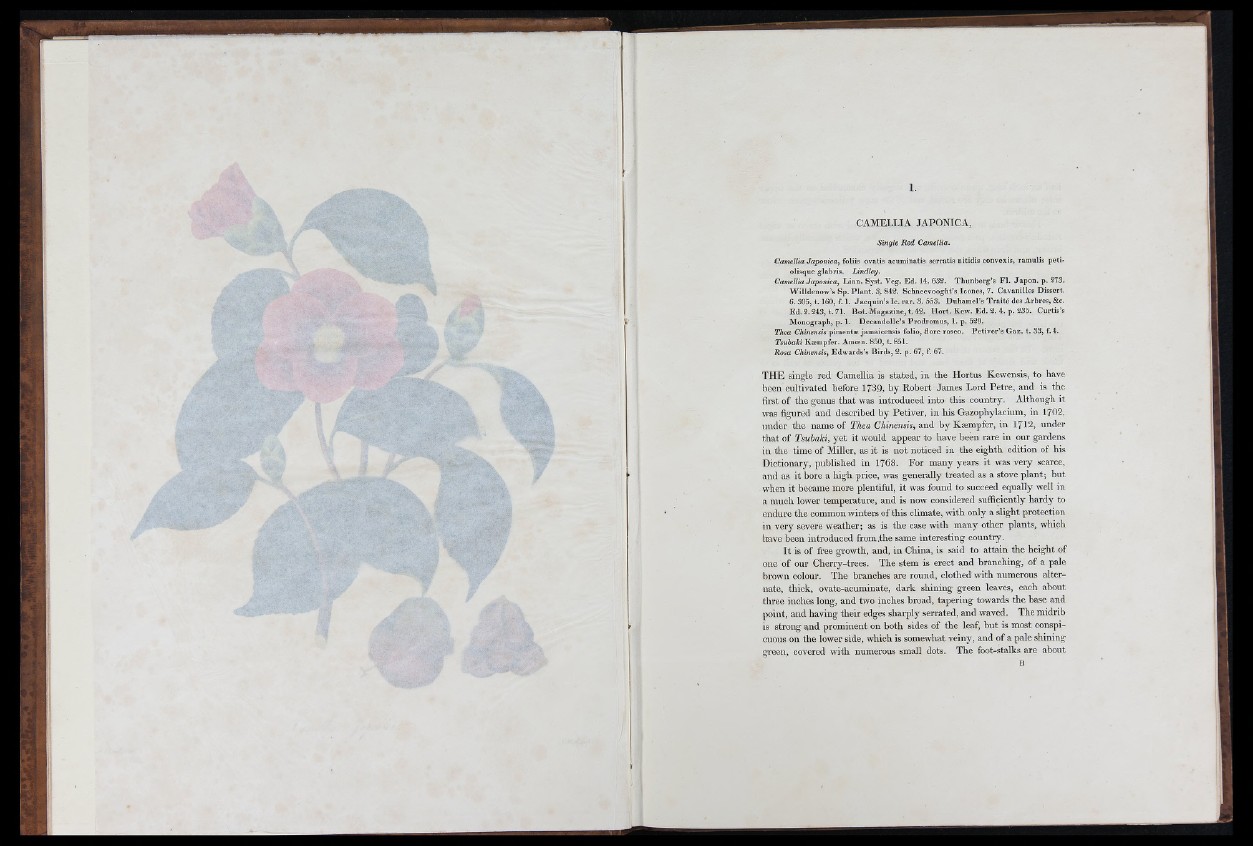
CAMELLIA JAPONICA,
Sin g le R e d Camellia.
Camellia Ja p ó n ica , foHis o v a tis a cum in a tis s e r r a tis n itid is co n v ex is, r am u lis p e ti-
o lisq u e g la b r is . L in d le y .
Camellia J a pónica, L in n . S y st. V e g . E d . 14. 632. T h u n b e r g ’s F I . J a p o n , p . 273.
W illd e n o w ’s S p . P l a n t . 3, 842. S ch n e e v o o g h t’s le o n e s , 7. C av a n ille s D is s e rt.
6. 305, t . 160, f. 1. J a c q u in ’s I c . r a r . S. 553. D u h am e l’s T r a i t é des A rb r e s , &c.
E d . 2 . 243, t . 71. B o t. M a g a z in e , t. 42. H o r t . K ew . E d . 2 . 4 . p . 235. C u r tis ’s
M o n o g r a p h , p . 1. D e c a n d o lle ’s P ro d rom u s , 1. p . 529.
Thea Chinensis p im en tæ jam a ic en s is fo lio , H ore ro seo . P e t iv e r ’s G a z . t . 33, f. 4.
T su b a k i K æm p fe r. A m oe n . 850, t . 851.
Rosa Chinensis, E dw a rd s ’s B ird s , 2. p . 67, f. 67.
TH E single red Camellia is stated, in the Hortus Kewensis, to have
been cultivated before 1739, by Robert James Lord Petre, and is the
first of th e genus th a t was introduced into this country. Although it
was figured and described b y Petiver, in his Gazophylacium, in 1702,
under the name of Thea Chinensis, and by Kæmpfer, in 1712, under
th a t of Tsubaki, y e t it would appear to have been rare in our gardens
in th e time of Miller, as it is not noticed in the eighth edition of his
Dictionary, published in I 76 8 . For many years it was very scarce,
and as it bore a high price, was generally treated as a stove plant ; but
when it became more plentiful, i t was found to succeed equally well in
a much lower temperature, and is now considered sufficiently hardy to
endure the common winters of this climate, with only a slight protection
in very severe weather; as is the case with many other plants, which
have been introduced from,the same interesting country.
I t is of free growth, and, in China, is said to attain the height of
one o f our Cherry-trees. The stem is erect and branching, of a pale
brown colour. The branches are round, clothed with numerous alternate,
thick, ovate-acuminate, dark shining green leaves, each about
three inches long, and two inches broad, tapering towards the base and
point, and having their edges sharply serrated, and waved. The m idrib
is strong and prominent on both sides of the leaf, b u t is most conspicuous
on the lower side, which is somewhat veiny, and of a pale shining-
green, covered with numerous small dots. The foot-stalks are about